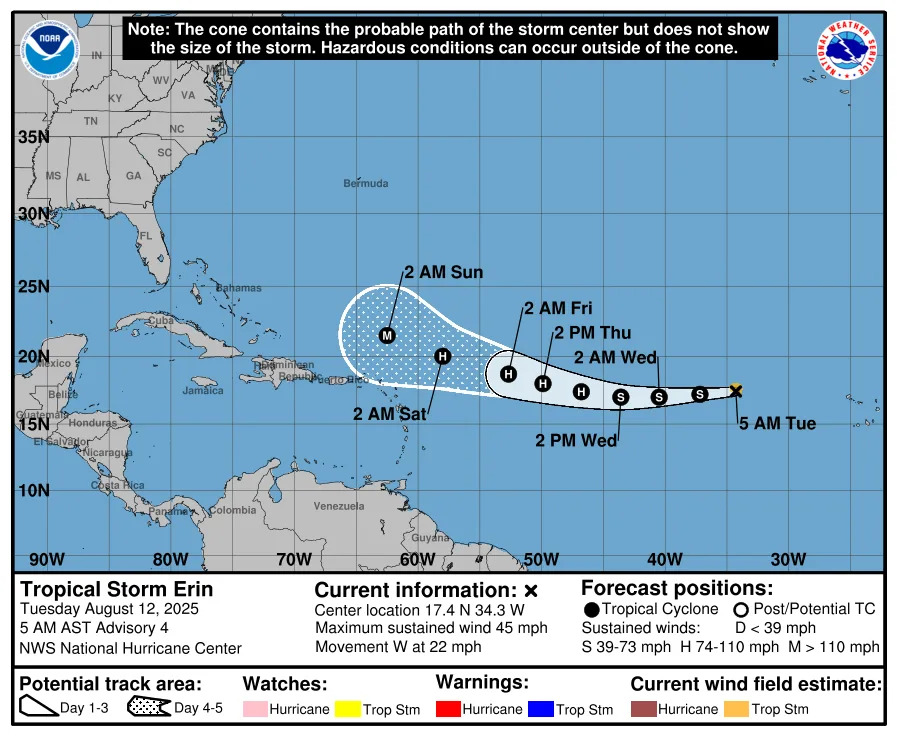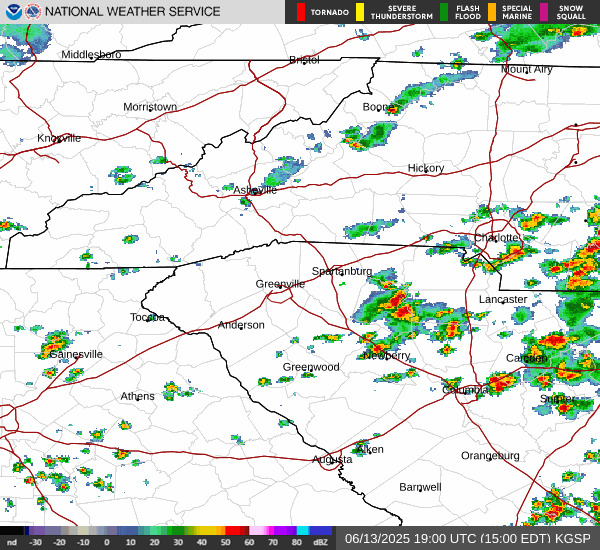Tropical Storm Erin is expected to become a hurricane within the next 24 hours as it tracks west-northwest toward the Greater Antilles, fueled by warmer-than-normal sea surface temperatures and strengthening upper-level winds.
The storm is also forecast to strengthen into a major hurricane, of Cat 3 strength or greater, by Sunday morning, Aug. 17, according to the latest advisory Aug. 14 from the National Hurricane Center. A major hurricane has wind speeds of at least 111 mph.
Erin is the fifth named storm of what forecasters predicted would be an above-average Atlantic hurricane season and would be the first to reach hurricane strength this year.
While the 2025 season may seem slow compared with 2024 — when Hurricane Beryl became the earliest Category 5 storm on record before its final landfall in Matagorda, Texas — Erin is actually right on schedule in terms of hurricane development.
Historically, the first hurricane forms around Aug. 11, the first major hurricane around Sept. 1 and the fifth named storm around Aug. 22, according to AccuWeather.
Forecasters say the season is entering its most active stretch. In their latest forecast, Colorado State University experts stuck to their July outlook of a slightly above-average season: 16 named storms, including eight hurricanes, three of them major.
A "normal" year sees 14 named storms, of which seven become hurricanes.
➤ Weather alerts via text: Sign up to get updates about current storms and weather events by location
Will Tropical Storm Erin impact North Carolina?
Special note on the NHC cone: The forecast track shows the most likely path of the center of the storm. It does not illustrate the full width of the storm or its impacts, and the center of the storm is likely to travel outside the cone up to 33% of the time.

Even as the system develops, all current models show Erin is likely to curve north before reaching the U.S., impacts along the East Coast are possible, especially dangerous surf and rip currents.
All models also show the core of Erin passing just north of the Leeward Islands, Virgin Islands and Puerto Rico, but locally heavy rainfall, high surf and rip currents, and tropical-storm force winds are still possible in these areas, according to the latest advisory.
Here's the latest update on Tropical Storm Erin.
Location: 900 miles east of the northern Leeward Islands
Maximum sustained winds: 50 mph
Movement: west at 27 mph
Pressure: 1,002 mb
Where is Tropical Storm Erin headed? See projected path
Tropical Storm Erin spaghetti models
Special note about spaghetti models: Illustrations include an array of forecast tools and models, and not all are created equal. The hurricane center uses only the top four or five highest performing models to help make its forecasts.
Will Invest 98L moving into the Gulf impact North Carolina?
A disturbance that emerged near Mexico’s coast on Wednesday, Aug. 13, has a low chance of developing as it moves into the southwestern Gulf on Aug. 14, according to the National Hurricane Center.
Although North Carolina sometimes feels impacts from Gulf-originating storms, this system is expected to track northwest from the Yucatán Peninsula, making it unlikely to affect the state.
How does the 2025 Atlantic hurricane season compared to last year in North Carolina?
For North Carolina, the season has been quiet so far, following a similar pattern to 2024.
Around this time last year, Tropical Storm Debby brought heavy rain, flash flooding, tropical storm–force wind gusts, minor coastal flooding and three weak tornadoes to southeastern North Carolina after making landfall in Florida's Big Bend region on Aug. 5, 2024, and then a second landfall in South Carolina's Bulls Bay between Charleston and Georgetown early on Aug. 8, 2024.
By late September, the state tracked Tropical Storm Helene, which caused flash floods, landslides and hundreds of fatalities fatalities after moving through the Appalachians.
So far, no storms have directly affected the state, but Colorado State researchers say North Carolina has one of the highest odds of seeing impacts from a hurricane or named storm this season — second only to Florida.
When is the Atlantic hurricane season?
The Atlantic hurricane season runs from June 1 through Nov. 30.
Ninety-seven percent of tropical cyclone activity occurs during this time period, NOAA said. The season peaks in August and September.
The Atlantic basin includes the northern Atlantic Ocean, Caribbean Sea and Gulf of America, as the Gulf of Mexico is now known in the U.S. per an order from President Trump. NOAA and the National Hurricane Center are now using Gulf of America on its maps and in its advisories.
Western North Carolina weather radar

North Carolina weather watches and warnings
Stay informed. Get weather alerts via text
Brandi D. Addison covers weather across the United States as the Weather Connect Reporter for the USA TODAY Network. She can be reached at [email protected].
This article originally appeared on Asheville Citizen Times: When will Tropical Storm Erin become a hurricane? NC expected impacts







Comments